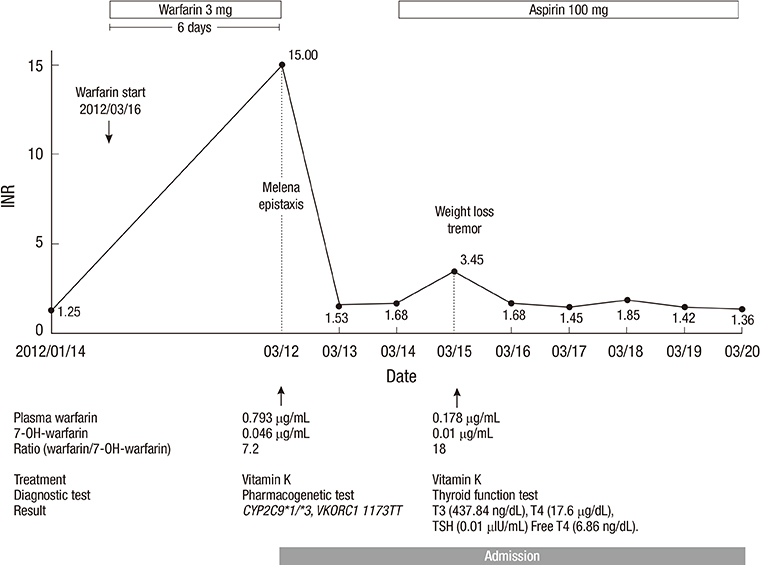J Korean Med Sci.
2014 Sep;29(9):1317-1319. 10.3346/jkms.2014.29.9.1317.
Extremely Elevated International Normalized Ratio of Warfarin in a Patient with CYP2C9*1/*3 and Thyrotoxicosis
- Affiliations
-
- 1Department of Medicine, Samsung Medical Center, Sungkyunkwan University School of Medicine, Seoul, Korea. juneskim@skku.edu
- 2Department of Laboratory Medicine and Genetics, Samsung Medical Center, Sungkyunkwan University School of Medicine, Seoul, Korea.
- KMID: 1794613
- DOI: http://doi.org/10.3346/jkms.2014.29.9.1317
Abstract
- A 73-yr-old Korean man with permanent atrial fibrillation visited outpatient clinic with severely increased International Normalized Ratio (INR) values after taking a usual starting dosage of warfarin to prevent thromboembolism. We found out later from his blood tests that he had hyperthyroidism at the time of treatment initiation. His genetic analysis showed CYP2C9*1/*3 and VKORC1+1173TT genotypes. We suspect that both hyperthyroidism and genetic variant would have contributed to his extremely increased INR at the beginning of warfarin therapy. From this case, we learned that pharmacogenetic and thyroid function test might be useful when deciding the starting dosage of warfarin in patients with atrial fibrillation.
MeSH Terms
-
Aged
Anticoagulants/blood/metabolism/therapeutic use
Aspirin/therapeutic use
Atrial Fibrillation/*diagnosis
Chromatography, High Pressure Liquid
Cytochrome P-450 CYP2C9/*genetics
Genotype
Humans
Male
Polymorphism, Single Nucleotide
Tandem Mass Spectrometry
Thromboembolism/prevention & control
Thyrotoxicosis/*diagnosis
Vitamin K Epoxide Reductases/genetics
Warfarin/*blood/metabolism/therapeutic use
Anticoagulants
Aspirin
Cytochrome P-450 CYP2C9
Vitamin K Epoxide Reductases
Warfarin
Figure
Reference
-
1. Eriksson N, Wadelius M. Prediction of warfarin dose: why, when and how? Pharmacogenomics. 2012; 13:429–440.2. Klein TE, Altman RB, Eriksson N, Gage BF, Kimmel SE, Lee MT, Limdi NA, Page D, Roden DM, Wagner MJ, et al. Estimation of the warfarin dose with clinical and pharmacogenetic data. N Engl J Med. 2009; 360:753–764.3. Stuijver DJ, van Zaane B, Romualdi E, Brandjes DP, Gerdes VE, Squizzato A. The effect of hyperthyroidism on procoagulant, anticoagulant and fibrinolytic factors: a systematic review and meta-analysis. Thromb Haemost. 2012; 108:1077–1088.4. Ma C, Zhang Y, Xu Q, Yang J, Zhang Y, Gao L, Xu B, Wang H, Li Y, Lu C, et al. Influence of warfarin dose-associated genotypes on the risk of hemorrhagic complications in Chinese patients on warfarin. Int J Hematol. 2012; 96:719–728.5. Squizzato A, Romualdi E, Büller HR, Gerdes VE. Clinical review: thyroid dysfunction and effects on coagulation and fibrinolysis: a systematic review. J Clin Endocrinol Metab. 2007; 92:2415–2420.6. Kurnik D, Loebstein R, Farfel Z, Ezra D, Halkin H, Olchovsky D. Complex drug-drug-disease interactions between amiodarone, warfarin, and the thyroid gland. Medicine (Baltimore). 2004; 83:107–113.7. Self T, Weisburst M, Wooten E, Straughn A, Oliver J. Warfarin-induced hypoprothrombinemia. Potentiation by hyperthyroidism. JAMA. 1975; 231:1165–1166.8. Vagenakis AG, Cote R, Miller ME, Braverman LE, Stohlman F Jr. Enhancement of warfarin-induced hypoprothrombinemia by thyrotoxicosis. Johns Hopkins Med J. 1972; 131:69–73.9. Olchovsky D, Pines A, Zwas ST, Itzchak Y, Halkin H. Apathetic thyrotoxicosis due to hemorrhage into a hyperfunctioning thyroid nodule after excessive anticoagulation. South Med J. 1985; 78:609–611.10. Tomisti L, Del Re M, Bartalena L, Tanda ML, Pucci A, Pambianco F, Danesi R, Braverman LE, Martino E, Bogazzi F. Effects of amiodarone, thyroid hormones and CYP2C9 and VKORC1 polymorphisms on warfarin metabolism: a review of the literature. Endocr Pract. 2013; 19:1043–1049.11. Kellett HA, Sawers JS, Boulton FE, Cholerton S, Park BK, Toft AD. Problems of anticoagulation with warfarin in hyperthyroidism. Q J Med. 1986; 58:43–51.
- Full Text Links
- Actions
-
Cited
- CITED
-
- Close
- Share
- Similar articles
-
- A Case Report of a Patient Carrying CYP2C9*3/4 Genotype with Extremely Low Warfarin Dose Requirement
- A Case of Intolerance to Warfarin Dosing in an Intermediate Metabolizer of CYP2C9
- Evaluation of the Verigene Warfarin Metabolism Nucleic Acid Test Kit for the Rapid Detection of CYP2C9 and VKORC1 Polymorphisms
- VKORC1 and CYP2C9 Genotype Variations in Relation to Warfarin Dosing in Korean Stroke Patients
- Development and Comparison of Warfarin Dosing Algorithms in Stroke Patients


